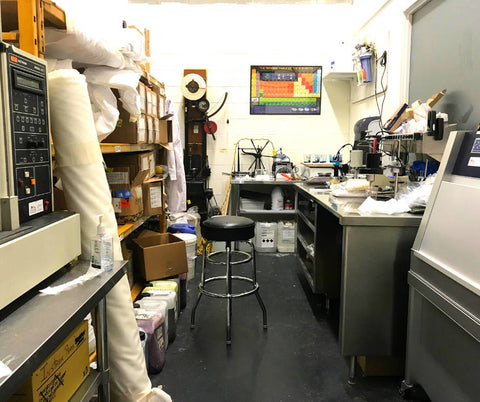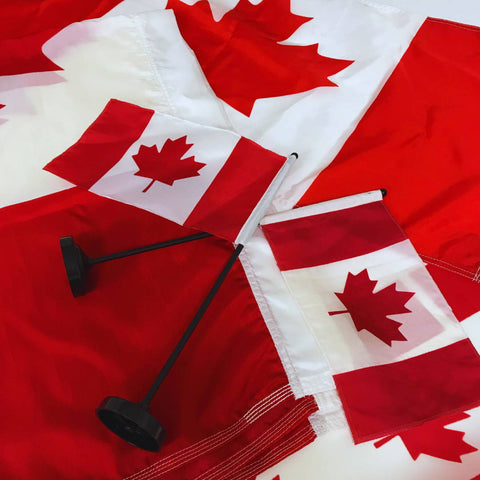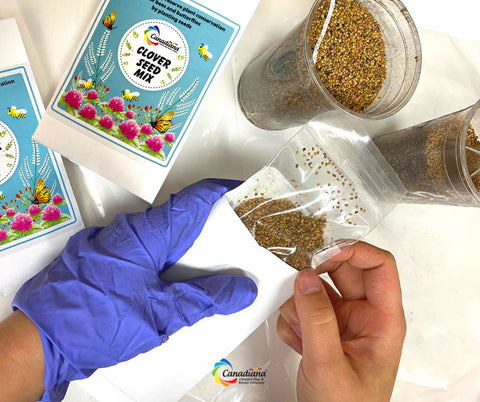The techniques of flag and banner manufacture have evolved over the years, from their original creation, probably in the Chinese Zhao dynasty in about 1050 B.C. Britannica.com has a wonderfully thorough history of flags.
The technology of flagmaking has evolved over the many centuries since, from a labour intensive process of embroidery and hand stitching to today’s more efficient digital technologies. Canadiana Flag is the forefront of developing that technology as the only Canadian flag manufacturer to have an in-house lab to test and new fabrics, inks, stitching and other elements involved in the flag making process.
If you’ve read our blog post on the history of the Canada flag—and if you haven’t, you can find it here —you’ll know that, well into the 20th Century, flag making was very much a hands-on endeavour. Flags were embroidered or stitched together from hand-cut elements. This is called the appliqué process; a flag making tradition that Canadiana Flag proudly carries on to this day. Its construction ensures a more solemn drape. They are less likely to fly in the wind, but their somber weightiness makes them ideal for state occasions for indoors, creating a more ceremonial and dimensional appearance. We’ll explore the intricacies of the appliqué process in a future post as this is a favourite Canada flag for indoor displays.
Screen Printed Flags
In the 1960s, screen printing became mainstream. The process had been pioneered in the Song Dynasty, about 1000 CE, as a means of transferring images to cloth, using cardboard stencils and a screen of human hair. Silk eventually supplanted human hair, and innovations in the early 20th Century made the process suitable for producing larger quantities of product. The humble squeegee was created to more evenly drive the ink through the screen. Photo-imaged stencils replaced cardboard. In the sixties, a rotatable four-colour screen press inspired artists like Andy Warhol and created a boom in the graphic T-shirt industry. Again, there’s a marvelous history of screen printing from the Western New York Book Arts Center
Our Flag Technology Journey 1850s-2021
Canadiana Flag stemmed from Flying Colours International, the largest flag manufacture in Canada. We first started out screen printing our flags back in the 50s, and assembled flags by cutting and hand sewing pieces together.
The process of creating a standard size of 72x36” flag , from start to finish took a few days to complete. We stored our silkscreen frames, where each frame was dedicated to one colour. Hence, we had a whole floor in our first building that was strictly filled with silk screened frames!
There was obvious potential for flag making, but there were also barriers. We constructed a rotary belt that was 2 school buses long to make the colour transfers onto fabric more efficient. One of the problems we faced was that colours starting overlapping as the belt needed time to be prepared for the next colour on the flag. It was difficult to get the clean colour cut you see on our flags today. For example, red would bleed onto the next set that only required blue. We needed a way to clean the belt and prepare it for the next set to avoid wrong colour transfers. Therefore, we installed washing procedures under the machine to get everything running a more clean manner.
Besides colour transfer, more environmental factors were considered to develop our expertise to produce the high quality we ensure to our customers today. We needed fabrics that could not only allow that penetration, but also withstand rain and the harsh Canadian weather. Not to mention some kind of UV resistant coating to prevent light colours from fading in the sun at an alarming rate.
Enter science, and our testing lab, the only one of its kind in Canada!
Flag Printing Science in the Only In House Lab in Canada
Traditional and modern techniques, like screen and digital printing, require compatible materials; fabric, substrates and inks. Developments in synthetics like nylon offered a more effective substrate and, eventually, digital printing. Additionally, the lighter weight of nylon flags compared to cotton in the 50s-70s allows the flag to flutter in the breeze more freely. Furthermore, we engineered our nylon material to become durable in outdoor conditions, providing a cost efficient alternative to our customers. In addition, nylon gives designs a more smooth and rich look, which is enhanced by its silky texture.
The “Tuffest” Canada Flag- Our Canada Tuff Fly Flag
Our Canada Tuff Fly flag is our best selling outdoor Canada flag. We engineered this Canada Flag to withstand the harsh weather conditions of Canada. The material is not only tested for its durability in our lab; it goes through real-life testing as well to assure it can stand up to the harsh realities of Canadian weather. It has been tested on marine boats and in the arctic. Furthermore, thanks to the Canadian Civil Defense Museum and Archives in Red Deer Alberta, our Canada flags fly over their radar installations surviving the winds and harsh conditions to bring some real-world confirmation to our lab results. Purchase a Canada Tuff Fly flag for your home, office, boat or cottage here.
Quality Maintenance
All flags fade in time—pastels faster than primary colours—but our lab engineers have worked on the colour penetration characteristics of dyes to extend colour-fastness beyond that of the industry standard. Another of our competitive advantages is our Colour Smart technology—at the moment, a closely guarded competitive advantage, which we’ll explore in further detail in a future post.
To guarantee quality, our in-house lab on a continuous basis tests the tear and breaking strength of flag fabrics both before and after weathering. All our products are finished with an after treatment for UV resistance and to provide a self cleaning feature when raining. Sunlight is a major cause of fading and overall deterioration. Our lab tests each dye to determine resistance to fading over a period of time and if necessary to adjust formulas to obtain better life expectancy




